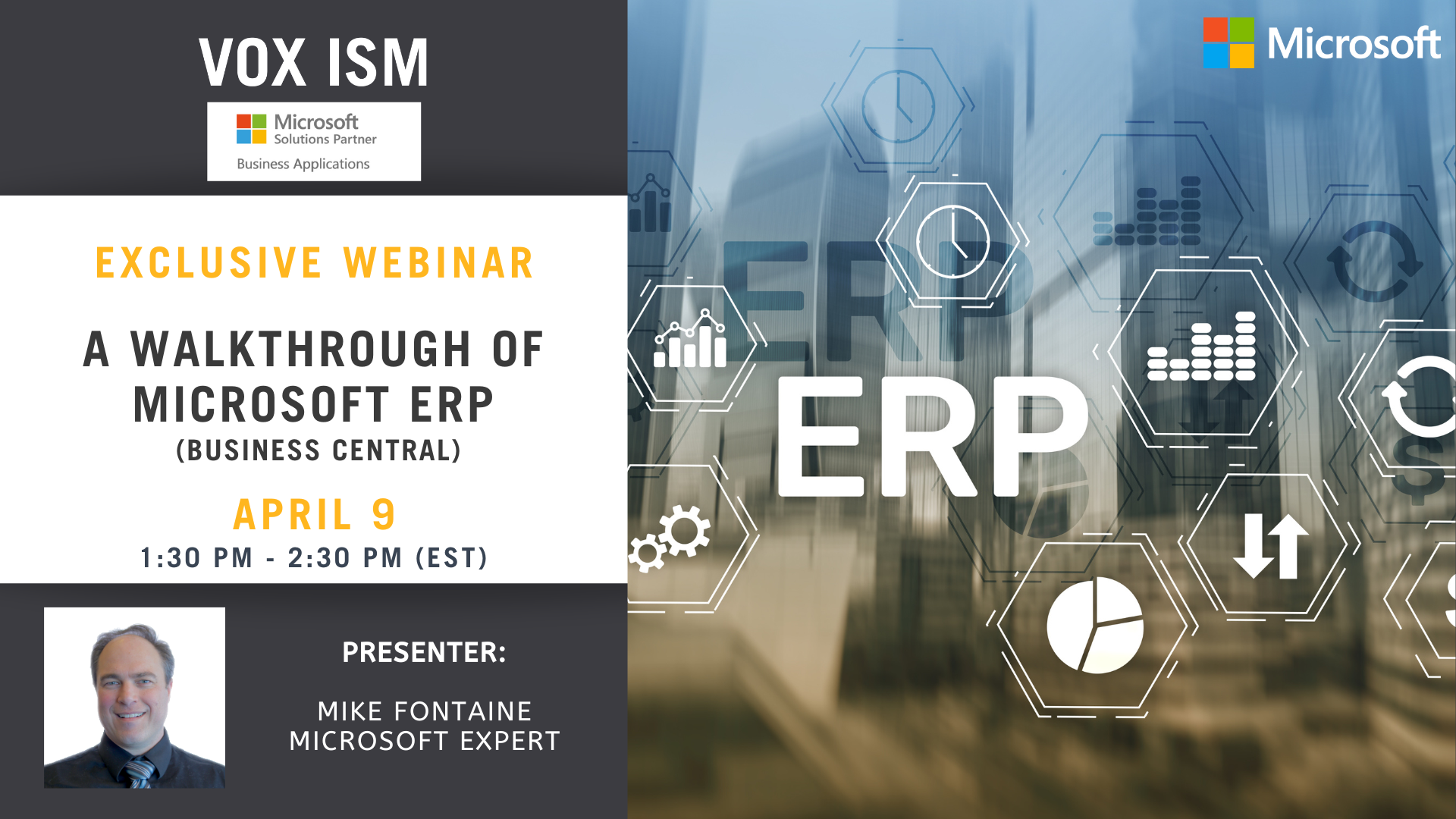A Walkthrough of Microsoft ERP (Business Central)
This webinar is a walkthrough for accountants and controllers looking for a general understanding of the basic accounting functions and transactions in Business Central operates and how the transactions flow into the GL.
Agenda
1. Exploring the Finance Module
a. Overview of features and tools for accountants
b. Drilling down from the trial balances to source transactions
c. Posting Journal Entries, tracking transactions with reasons and documents
d. Discussion on dimensions and account segmentation.
2. Handling Customer and Vendor Transactions
a. Enter orders.
b. Posting Invoices
c. Processing payments
d. Review of GL
3. Running financial reports
a. How to create and run balance sheets and income statements
b. Setting up budgets and analyzing financial data
4. Automation and Efficiency
a. Workflows
b. Batch Processing
c. Integrations
d. Services
Eliminate your C & D drives with SharePoint
Agenda:
1. Introduction to SharePoint
2. Creating Folders
3. Creating Metatags
4. Version control
5. Integration into Teams
6. Searching, Sorting
How to use AI for Accounting
Microsoft Dynamics Business Central has 43 integrated modules that allows you to make 1 transaction instead of 3 that most stand-alone accounting systems (QuickBooks, Accpac) make you do. In addition, the software has your industries best accounting and finance practices already built in!
In the webinar we will cover:
· Multi currency, languages, taxes
· 3 forms of costing (Projects, Work Orders, Service)
· Budgeting & Forecasting
· Power BI, analytics, and reporting
· Teams, communications
· SharePoint – document management
· HR
· Fixed Assets
· Job Costing, Project Costing, Change Orders, and revenue Rec.
· Supply chain – 3-way match
· Bar coding & Shop Floor reporting
Having all of your accounting and financial information in the same place will save your accounting department time, let them better manage critical accounting tasks, and do big jobs faster — like close out a month in almost half the time it used to take.
Microsoft Software to Run your Shop Floor
Gain practical insights and proven strategies for optimizing shop floor operations. Discover how to enhance efficiency, reduce downtime, and increase productivity, ensuring a smoother, more profitable manufacturing process.
Agenda
1. Overview of Manufacturing Capabilities in Business Central
2. Planning and Scheduling
3. Workforce Management
4. Leverage Technology
5. Maintaining Equipment
6. Quality and Safety
In this presentation, explore a comprehensive guide to managing a successful shop floor with the most advanced tools and technologies.
Begin by assessing your shop floor’s capacity and resource utilization, laying a strong foundation for enhanced efficiency. Discover methods to instantly capture and relay time data from the shop floor control workstations and learn the art of summarizing and showcasing this information through intuitive dashboards.
Dive into workforce management with the Dynamics 365 Human Resources module. Explore the power of Artificial Intelligence and Internet of Things in boosting operational efficiency and harnessing optimal output.
Conclude by establishing a robust preventative maintenance system in Business Central, complemented by efficient capturing of quality and safety records, ensuring your shop floor not only runs seamlessly but also stands the test of time.
Embark on this journey to streamline your shop floor operations, ensuring they are as efficient, productive, and technologically advanced as possible.
Microsoft Cloud for Manufacturing
Strengthen your manufacturing business by connecting systems and data, allowing you to anticipate change, minimize disruptions, and reduce time to market—all while building better customer relationships using real-time insights.
Agenda:
1. Product Design and Control
a. Introduce new products and services quickly.
b. Centrally manage product information.
c. Streamline engineering change management processes.
d. Improve safety, quality, and productivity with hands-free work instructions.
2. Supply Chain
a. Six trends shaping supply chain transformation
b. Stay ahead of supply chain disruptions and keep up with customer demand by transforming from a legacy approach to a resilient manufacturing supply chain model.
3. Production and distribution
a. Get support for discrete, process, lean, and mixed-mode manufacturing.
b. Drive sustainable manufacturing with connected factories using IoT and AI.
c. Fulfill orders effectively with Intelligent order and warehouse management.
d. Manage inventory with real-time data.
4. Sales
a. Build trust and strengthen relationships with customers.
b. Streamline and automate sales processes to sell new leads and identify opportunities with existing customers.
c. Track relationship needs and relationship health with real-time insights.
d. Personalize customer engagements across multiple channels to cultivate and maintain long-term relationships.
5. Service
a. Increase customer loyalty by providing exceptional service.
b. Proactive field service including AI-optimized scheduling
c. Omnichannel and self-service customer service
Converting Microsoft Dynamics From on Premise to the Cloud
Welcome and Introduction: We’ll kick off the webinar with a brief overview of the current landscape for businesses utilizing on-premise Microsoft Dynamics solutions. Understanding the strategic importance of cloud migration, we will outline the objectives of the webinar, including key benefits and considerations for Canadian businesses making the shift to Microsoft Cloud.
Transitioning to Microsoft Cloud – Key Steps and Best Practices: This section delves into the heart of the migration process. We’ll cover a step-by-step guide on how to plan and execute a seamless transition from on-premise Microsoft Dynamics to Microsoft Cloud. Topics will include data migration strategies, integration of existing business processes, and ensuring compliance with Canadian data protection regulations. Attendees will gain insights into best practices for minimizing downtime and ensuring a smooth transition for their operations.
Q&A and Wrap-Up: The webinar will conclude with an interactive Q&A session, providing attendees the opportunity to address specific concerns and queries related to their businesses. We’ll wrap up by summarizing key takeaways from the session and offering resources for further assistance on the migration journey, including how to leverage Microsoft’s support services and partner ecosystem in Canada.
Microsoft Cloud for Canadian Distributors
Harness the power of Microsoft Cloud to optimize your distribution operations, ensuring real-time responsiveness, reducing overheads, and delivering exceptional customer service. Discover how to revolutionize your distribution channels with data-driven insights and advanced cloud technology.
Agenda:
Inventory Management and Product Distribution
- Accelerate product distribution with enhanced inventory control and efficient management processes.
- Centralize product information for better accessibility and consistency.
- Implement advanced tracking and predictive analytics for inventory optimization.
Supply Chain Agility
- Explore six pivotal trends driving supply chain agility and resilience.
- Transition from traditional to dynamic, data-informed supply chain models to mitigate disruptions and meet evolving customer demands.
Smart Distribution Operations
- Support diverse distribution models with adaptive, scalable solutions.
- Leverage IoT and AI for smarter warehouse management and logistics.
- Optimize order fulfillment with intelligent order management systems and real-time data insights.
Sales and Customer Relationships
- Foster trust and cultivate long-term customer relationships with data-driven sales strategies.
- Automate and streamline sales processes to engage new leads and grow opportunities with current clients.
- Utilize real-time analytics to understand customer needs and monitor relationship health.
Enhanced Customer Service
- Boost customer retention by delivering proactive and exceptional service experiences.
- Integrate AI-optimized scheduling for efficient field service management.
- Offer omnichannel and self-service options to meet modern customer service expectations.
Microsoft Cloud for Canadian Manufactures
Strengthen your manufacturing business by connecting systems and data, allowing you to anticipate change, minimize disruptions, and reduce time to market—all while building better customer relationships using real-time insights.
Agenda:
- Product Design and Control
- Introduce new products and services quickly.
- Centrally manage product information.
- Streamline engineering change management processes.
- Improve safety, quality, and productivity with hands-free work instructions.
- Supply Chain
- Six trends shaping supply chain transformation
- Stay ahead of supply chain disruptions and keep up with customer demand by transforming from a legacy approach to a resilient manufacturing supply chain model.
- Production and Distribution
- Get support for discrete, process, lean, and mixed-mode manufacturing.
- Drive sustainable manufacturing with connected factories using IoT and AI.
- Fulfill orders effectively with Intelligent order and warehouse management.
- Manage inventory with real-time data.
- Sales
- Build trust and strengthen relationships with customers.
- Streamline and automate sales processes to sell new leads and identify opportunities with existing customers.
- Track relationship needs and relationship health with real-time insights.
- Personalize customer engagements across multiple channels to cultivate and maintain long-term relationships.
- Service
- Increase customer loyalty by providing exceptional service.
- Proactive field service including AI-optimized scheduling
- Omnichannel and self-service customer service.
Managing Projects, and Project Reporting
The Microsoft Dynamics 365 is a powerful tool that allows organizations to manage their project-based services from start to finish. It provides a comprehensive set of features that help organizations plan projects, create estimates and work schedules, estimate and track project cost and revenue, forecast resource requirements, track project progress and cost consumption, manage quoting, pricing, and billing for projects, assign and manage resources, and use reports and interactive dashboards to monitor key performance indicators for successful projects.
One of the key features of PSA is the ability for individual consultants to easily enter and track project time and expenses either on mobile or using a web browser, this allows to monitor and control costs for your project-based work.
In this webinar we will demonstrate all aspects of project management, from sales and estimates to resource planning and billing and finish with Project Reporting and Dashboards
Agenda
1. Overview of Technology
2. Projects and Project Structure
3. Planning and purchasing
4. Time Entry
5. Costing
6. Billing
7. Reporting
Walkthrough of Microsoft ERP Software, Business Central
Agenda
1. Quote to Cash
2. Procure to Pay
3. Manufacturing
4. Supply Chain
5. Inventory Control
6. Accounting
7. Integration with Microsoft 365 (formerly Office 365) products: Power BI, TEAMS, AI, and
Workflows










